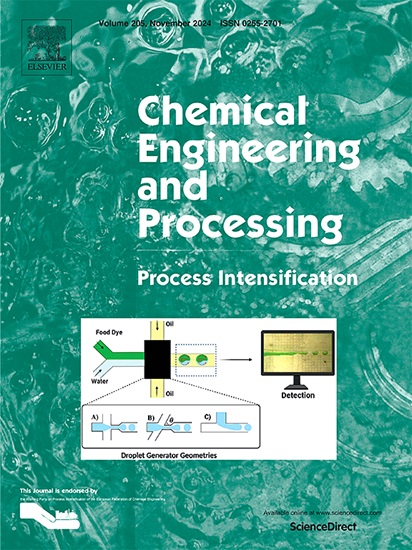Fast liquid–liquid dispersion for low volumina in an active micromixer — AI-based investigation
IF 3.8
3区 工程技术
Q3 ENERGY & FUELS
Chemical Engineering and Processing - Process Intensification
Pub Date : 2025-05-27
DOI:10.1016/j.cep.2025.110362
引用次数: 0
Abstract
Miniaturized equipment offers many benefits for mixing and liquid–liquid dispersion processes, such as fast and controllable mixing, high surface-to-volume ratio, and lower specific energy consumption. Rapidly changing product mixtures, as can be found in cosmetics industry, require special knowledge of the performance of the mixing and emulsification processes. Here, the droplet size distribution (DSD) is important to define the quality, consistency, and stability of the product and is often regarded as a critical quality attribute. In this work, a modified microstructured annular gear pump is examined as an active mixer for emulsification processes. The active micromixer has the benefit that the mixing power can be freely adjusted, independently of the volumetric flow rate, which enables performance investigation of the DSD based on the specific energy dissipation rate. Important process parameters, such as volumetric flow rate (0.5 to 1.5 mLmin-1), rotor speed (6000 to 12000 min-1) , and mass fraction of the dispersed phase (10 to 18.4 w% of the oil phase) are examined to investigate their effects on the DSD. For this, an AI-based image recognition is used for emulsion characterization. This methodology provides real-time monitoring and the opportunity to define operation ranges for rapid optimization of rotor, housing, geometry of mixing devices, and further process conditions such as volumetric flow rate for liquid–liquid mixing.

主动微混合器中小体积快速液液分散——基于人工智能的研究
小型化的设备为混合和液-液分散过程提供了许多好处,例如快速和可控的混合,高表面体积比和较低的比能耗。快速变化的产品混合物,可以发现在化妆品行业,需要特殊的知识,混合和乳化过程的性能。在这里,液滴尺寸分布(DSD)对于定义产品的质量、一致性和稳定性非常重要,并且通常被视为关键的质量属性。在这项工作中,研究了一种改进的微结构环形齿轮泵作为乳化过程的主动混合器。主动微混合器的优点是混合功率可以自由调节,不受体积流量的影响,这使得基于比能量耗散率的DSD性能研究成为可能。考察了体积流量(0.5 ~ 1.5 mL·min-1)、转子转速(6000 ~ 12000 min-1)、分散相质量分数(油相质量分数的10 ~ 18.4 w%)等重要工艺参数对DSD的影响。为此,基于人工智能的图像识别被用于乳液表征。该方法提供了实时监控和定义操作范围的机会,以快速优化转子,外壳,混合装置的几何形状,以及进一步的工艺条件,如液-液混合的体积流量。
本文章由计算机程序翻译,如有差异,请以英文原文为准。
求助全文
约1分钟内获得全文
求助全文
来源期刊
CiteScore
7.80
自引率
9.30%
发文量
408
审稿时长
49 days
期刊介绍:
Chemical Engineering and Processing: Process Intensification is intended for practicing researchers in industry and academia, working in the field of Process Engineering and related to the subject of Process Intensification.Articles published in the Journal demonstrate how novel discoveries, developments and theories in the field of Process Engineering and in particular Process Intensification may be used for analysis and design of innovative equipment and processing methods with substantially improved sustainability, efficiency and environmental performance.

 求助内容:
求助内容: 应助结果提醒方式:
应助结果提醒方式:


